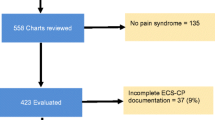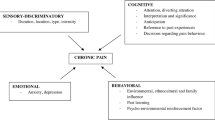Abstract
Objective
The purpose of this paper is to provide an overview of the development of a “TNM“ cancer pain classification system for advanced cancer patients, the Edmonton Classification System for Cancer Pain (ECS-CP). Until we have a common international language to discuss cancer pain, understanding differences in clinical and research experience in opioid rotation and use remains problematic. The complexity of the cancer pain experience presents unique challenges for the classification of pain. To date, no universally accepted pain classification measure can accurately predict the complexity of pain management, particularly for patients with cancer pain that is difficult to treat.
Materials and methods
In response to this gap in clinical assessment, the Edmonton Staging System (ESS), a classification system for cancer pain, was developed. Difficulties in definitions and interpretation of some aspects of the ESS restricted acceptance and widespread use.
Result
Construct, inter-rater reliability, and predictive validity evidence have contributed to the development of the ECS-CP. The five features of the ECS-CP—Pain Mechanism, Incident Pain, Psychological Distress, Addictive Behavior and Cognitive Function—have demonstrated value in predicting pain management complexity.
Conclusion
The development of a standardized classification system that is comprehensive, prognostic and simple to use could provide a common language for clinical management and research of cancer pain. An international study to assess the inter-rater reliability and predictive value of the ECS-CP is currently in progress.
Similar content being viewed by others
References
Agency for Health Care Policy and Research (1994) Management of cancer pain: adults. Am J Hosp Pharm 51:1643–1656
Arner S, Meyerson BA (1988) Lack of analgesic effect of opioids on neuropathic and idiopathic forms of pain. Pain 33:11–23
Arner S (1998) Pain analysis in prediction of treatment outcome. Acta Anaesth Scand Suppl 113:24–28
Boisvert M, Cohen SR (1995) Opioid use in advanced malignant disease: why do different centres use vastly different doses? A plea for standardized reporting. J Pain Symptom Manage 10:632–638
Bruera E, Fainsinger R, Spachynski K et al (1995) Clinical efficacy and safety of a novel controlled-release morphine suppository and subcutaneous morphine in cancer pain: a randomized evaluation. J Clin Oncol 13:1520–1527
Bruera E, Macmillan K, Hanson J, MacDonald RN (1989) The Edmonton staging system for cancer pain: preliminary report. Pain 37:203–209
Bruera E, Moyano J, Seifert L, Fainsinger RL et al (1995) The frequency of alcoholism among patients with pain due to terminal cancer. J Pain Symptom Manage 10:599–603
Bruera E, Schoeller T, Wenk R et al (1995) A prospective multicenter assessment of the Edmonton staging system for cancer pain. J Pain Symptom Manage 10:348–355
Bruera E, Sloan P, Mount B et al (1996) A randomized, double-blind, double-dummy, crossover trial comparing the safety and efficacy of oral sustained-release hydromorphone with immediate-release hydromorphone in patients with cancer pain. Canadian Palliative Care Clinical Trials Group. J Clin Oncol 14:1713–1717
Bruera E, Watanabe S, Fainsinger RL et al (1995) Custom-made capsules and suppositories of methadone for patients on high-dose opioids for cancer pain. Pain 62:141–146
Caraceni A, Portenoy RK (1991) An international survey of cancer pain characteristics and syndromes. IASP Task Force on Cancer Pain. International Association for the Study of Pain. Pain 82:263–274
Caraceni A (1996) Clinicopathologic correlates of common cancer pain syndromes. Hematol Oncol Clin North Am 10:57–58
De Stoutz ND, Bruera E, Suarez-Almazor M (1995) Opioid rotation for toxicity reduction in terminal cancer patients. J Pain Symptom Manage 10:378–384
Ernst DS, Brasher P, Hagen N et al (1997) A randomized, controlled trial of intravenous clodronate in patients with metastatic bone disease and pain. J Pain Symptom Manage 13:319–326
Fainsinger RL, Lowe S, Nekolaichuk C, Lawlor P (2006) Is pain intensity predictive for complexity of Cancer Pain? Palliat Med 20(3):269
Fainsinger RL, Nekolaichuk CL, Lawlor PG, Neumann CM, Hanson J, Vigano A (2005) A multicentre validation study of the Revised Edmonton Staging System for classifying cancer pain in advanced cancer patients. J Pain Symptom Manage 29:224–237
Fainsinger RL, Nekolaichuk CL, Lawlor PG, Neumann CM. Edmonton classification system for cancer pain (ECS-CP). http://www.palliative.org/PC/Clinicalinfo/AssessmentToolsIDX.html
Fainsinger RL, Toro R (1998) Opioids, confusion in opioid rotation. Palliat Med 12:463–464
Foley K (2000) Pain assessment and cancer pain syndromes. In: Doyle D, Hanks G, MacDonald N (eds) Oxford textbook of palliative medicine. Oxford University Press, Oxford, pp 310–331
Hanks G, Portenoy RK, MacDonald N et al (2000) Difficult pain problems. In: Doyle D, Hanks G, MacDonald N (eds) Oxford textbook of palliative medicine. Oxford University Press, Oxford, pp 454–477
Hwang S, Chang V, Kasimis B (2003) Cancer breakthrough pain characteristics and responses to treatment at VA Medical Centre. Pain 101:55–64
Hwang SS, Chang VT, Fairclough DL et al (2002) Development of a cancer pain prognostic scale. J Pain Symptom Manage 24(4):366–378
Jadad AR, Carroll D, Glynn CJ et al (1992) Morphine responsiveness of chronic pain: double-blind randomized crossover study with patient-controlled analgesia. Lancet 339:1367–1371
Kaiko RF, Wallenstein SL, Rogers AG et al (1982) Narcotics in the elderly. Med Clin North Am 66:1079–1089
Lawlor P, Walker P, Bruera E et al (1997) Severe opioid toxicity and somatization of psychosocial distress in a cancer patient with a background of chemical dependence. J Pain Symptom Manage 13:356–361
Levy MH (1996) Pharmacologic treatment of cancer pain. New Engl J Med 335:1124–1132
Lowe S, Nekolaichuk C, Fainsinger R, Lawlor P (2008) Should the rate of opioid dose escalation be included as a factor in a Cancer Pain Classification System? J Pain Symptom Manage 35(1):51–57
Lutfy K, Yoburn BC (1991) The role of opioid receptor density in morphine tolerance. J Pharmacol Exp Ther 256:575–580
Mercadante S, Casuccio A, Pumo S et al (2000) Factors influencing the opioid response in advanced cancer patients with pain followed at home: The effects of age and gender. Support Care in Cancer 8:123–130
Mercadante S, Fulfaro F, Casuccio A et al (1999) Investigation of an opioid response categorization in advanced cancer patients. J Pain Symptom Manage 18:347–352
Nekolaichuk C, Fainsinger R, Lawlor P (2005) A validation study of a pain classification system for advanced cancer patients using content experts: the Edmonton classification system for cancer pain. Palliat Med 19(6):466–476
Otis-Green S, Sherman R, Perez M et al (2002) An integrated psychosocial-spiritual model for cancer pain management. Cancer Pract 10(suppl 1):S58–S64
Passik SD, Portenoy RK, Ricketts PL (1998) Substance abuse issues in cancer patients. Part 1: Prevalence and diagnosis.. Oncology 12:517–521
Passik SD, Portenoy RK, Ricketts PL (1998) Substance abuse issues in cancer patients. Part 2: Evaluation and treatment. Clin Tech Small Anim Pract 13:65–69
Passik SD, Theobald DE (2000) Managing addiction in advanced cancer patients: why bother? J Pain Symptom Manage 19:229–234
Piccirillo OJ, Feinstein A (1996) Clinical symptoms and co-morbidity: significance for the prognostic classification of cancer. Cancer 77:834–842
Portenoy RK, Foley KM, Inturrisi CE (1990) The nature of opioid responsiveness and its implications for neuropathic pain: new hypotheses derived from studies of opioid infusions. Pain 43:273–286
Portenoy RK, Lesage P (1999) Management of cancer pain. Lancet 353:1695–1700
Portenoy RK, Payne D, Jacobsen P (1999) Breakthrough pain: characteristics and impact in patients with cancer pain. Pain 81:129–134
Sellers AH (1971) The clinical classification of malignant tumors: the TNM system. CMAJ 105:836–843
South SM, Smith MT (2001) Analgesic tolerance to opioids. Pain 9(5):1–4
Sutton LM, Porter LS, Keefe FJ (2002) Cancer pain at the end of life: a biopsychosocial perspective. Pain 99:5–10
Ventafridda V, Tamburini M, Caraceni A, De Conno F, Naldi F (1987) A validation study of the WHO method for cancer pain relief. Cancer 59:850–56
Woolf CJ, Decosterd I (1999) Implications of recent advances in the understanding of pain pathophysiology for the assessment of pain in patients. Pain Suppl 6:S141–S147
Zaza C, Baine N (2002) Cancer pain and psychosocial factors: a critical view of the literature. J Pain Symptom Manage 24:526–542
Zech DF, Grond S, Lynch J, Hertel D, Lehmann KA (1995) Validation of the World Health Organization guidelines for cancer pain relief: a 10-year retrospective study. Pain 63:65–76
Acknowledgments
Robin Fainsinger and Cheryl Nekolaichuk are supported by the Canadian Institutes of Health Research through grant support for the CIHR New Emerging Team in Difficult Pain Problems (CIHR PET69772) and an international multicenter validation study of a pain classification system for advanced cancer patients.
Author information
Authors and Affiliations
Corresponding author
Additional information
Presented as an invited lecture at the MASCC/ISOO 20th Anniversary International Symposium Supportive Care in Cancer in St. Gallen, June 2007.
Appendices
Appendix 1

Appendix 2



Rights and permissions
About this article
Cite this article
Fainsinger, R.L., Nekolaichuk, C.L. A “TNM” classification system for cancer pain: The Edmonton Classification System for Cancer Pain (ECS-CP). Support Care Cancer 16, 547–555 (2008). https://doi.org/10.1007/s00520-008-0423-3
Received:
Accepted:
Published:
Issue Date:
DOI: https://doi.org/10.1007/s00520-008-0423-3




